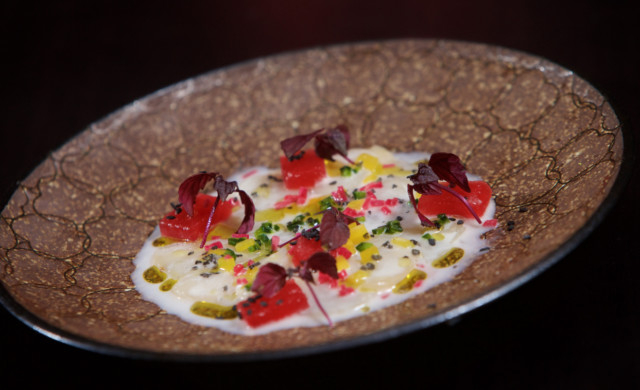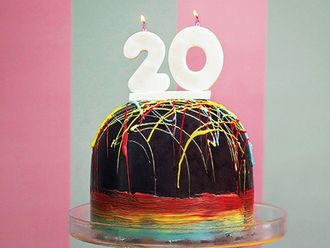
The sign outside the Westin is massive, with the unusual logo of China Grill — a medieval-style coat of arms with chopsticks — dominating Al Sufouh Road. The famous New York spot is finally here, to serve up European-American dishes seen through an Asian flavour lens — and vice versa.
“Somebody 15 or 20 years ago said, it’s not Chinese and it’s not a grill but you’ll have a great time there. The name is a whole other story, but it’s Asian-inspired and globally influenced,” says Geoffrey Chodorow, the founder and owner of the China Grill concept (and its sister restaurant, Asia De Cuba).
Chodorow started China Grill in New York 27 years ago, when Asian-European sharing dishes were unheard of (“people were shocked”, he says) and it’s still going strong, with its mix of a bar-lounge vibe and that menu.
“We don’t limit ourselves,” says Chodorow. “While the menu here is fundamentally Asian, it takes inspiration from around the world. There are dishes that you would find in Hakkasan, like Peking duck, that we hope to make as good or better. But you will also find a lot of good things that you would not find on any other menu, like the tempura sashimi, for example. We take Asian literally — so you’ll find Indonesian, Thai, Japanese, Chinese influences from every part of Asia, and techniques from Italy.”
One dish in particular sums this concept up for Chodrow: His wife’s favourite veal Milanese with salad on top. “So we did a panko-crusted veal with an Asian salad. Italian roots, Asian execution.” (It’s not on the menu right now, however.)
Enter by that huge sign to go to the separate valet entrance (which is becoming a defining feature for any cool new spot, it appears), where you’ll be greeted and shown to a glossy lift to the venue. Inside, it’s dark, sleek and sexy, with a massive lounge and bar above and a spacious, though intimate-feeling restaurant downstairs. The aim here is to have diners come to drink, eat, then party some more.
Dubai’s party-restaurants haven’t always gotten the food right, but there’s plenty of great items to feast on here, especially from the dim sum, sushi and small plates selection — some of them are among my favourite Dubai dishes right now. I found that the mains, however, need to punch up the flavour.
The duck jaozi (Dh85), for example — an unusual, incredibly rich and meaty take on steamed dumplings that’s good enough to make you question why anyone would bother wrapping duck meat in a pancake. These are a double-order dish.
Spicy beef dumplings (Dh85) are equally full of flavour, but couldn’t shine as bright next to the duck. Lobster and king scallop siew mai (Dh80) are seafood-sweet and oversized (actually, all the dim sum are on the large side).
Though our friendly waitress had many, many favourites on the menu, pointing us towards the sushi items such as a rainbow roll and a dragon roll, my dining partner and I preferred to pick from the small plates, which offered some unexpected tastes. Being suckers for anything aubergine and burrata, we were sad to hear the miso-glazed pairing of the two was finished for the night — there’s another reason to head back, then.
The lamb spare ribs — one of Chodorow’s must-tries — were fall-off-the-bone tender, sticky-sweet, with a plum and sesame glaze that reminded me of those sweet miso glazes you get on cod at Japanese restaurants. My dining partner lapped them up; I found they suffered from a lack of lamb flavour. A great sharing dish with drinks, a crisp-chewy Beijing-style pastry pancake with green onion and lobster (Dh85) comes with — oh yes — a truffle butter dipping sauce.
Finally, the jalapeno-lime cured scallops, a beautiful plate if there ever was one, with thin slices of raw, sweet, buttery scallop topped with coconut milk and chunks of watermelon. The flavour profile was subtle and refreshing, and the texture soft. One caveat: the watermelon was advertised as “pressed”, a technique that gives it a jelly-like texture. It was, however, regular watermelon — still a nice ingredient.
For two people, you could easily stop at this point, as portions are generous and any more food may impede socialising upstairs. But we pressed on to try a few recommended mains: the tea-smoked Chilean seabass, wasabi mashed potatoes, and Confucian chicken salad. Perhaps it’s because most of the starters had shining flavours, but all the mains were lacking — wasabi was on top of the mash, but not mixed in; we had expected a whoosh of heat. The seabass was incredibly oily, and the pomelo salad underneath didn’t provide the necessary sharpness; as a combo it did not appeal. The chicken salad also felt bland.
My advice: Enjoy a large selection of starters, sushi and small plates, and make sure you have room for one of the best desserts in Dubai: The Jien Duy Good Fortune Box (Dh85). Not only is the box stunning — a three-tier red-and-black Chinese design — it holds dessert treasures enough for four hungry ladies. Inside are fried and steamed crisp-chewy sesame balls filled with either raspberry, sesame peanut, chocolate peanut, spicy chocolate and black sesame. The chocolate dip is not even necessary, but who’s going to pass up a bowl of that? Without wanting to ruin the surprise, make sure you try the citrus bonbon — it’s more fun than even dessert has a right to be.












